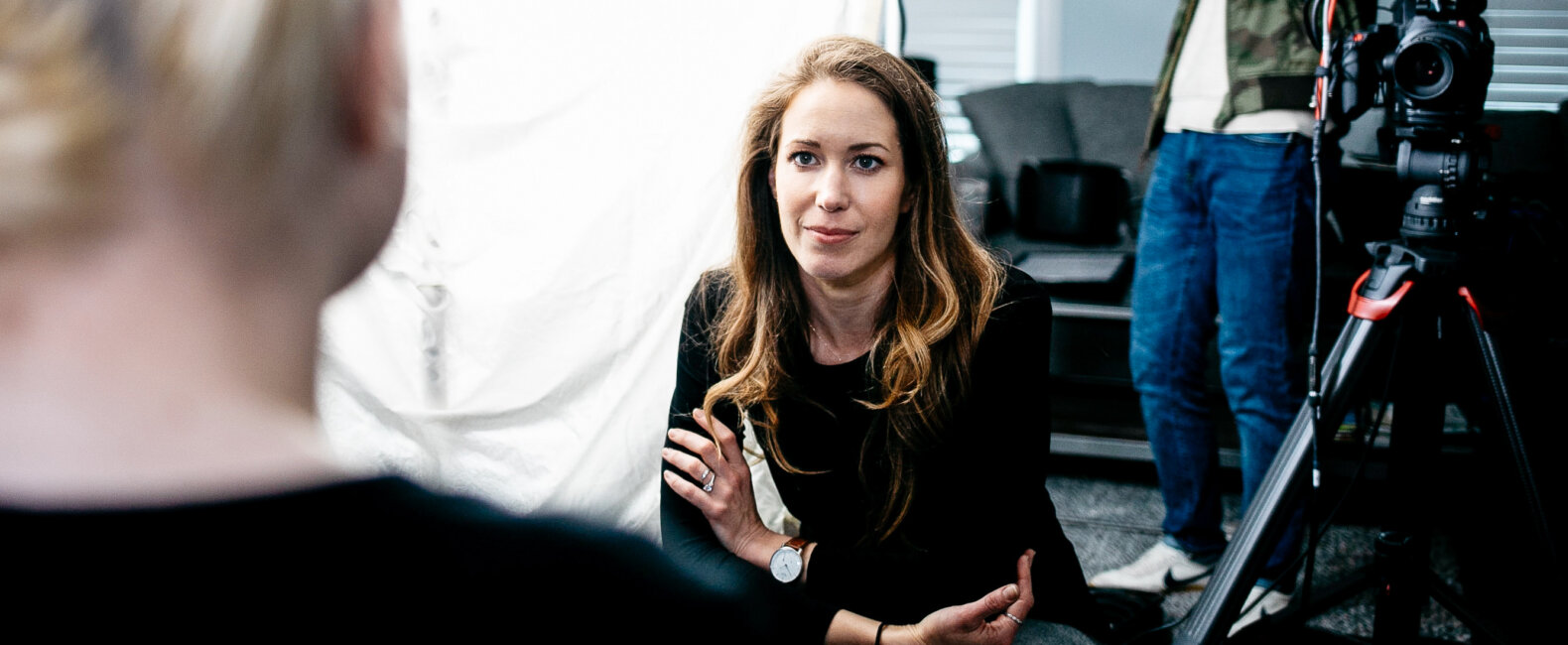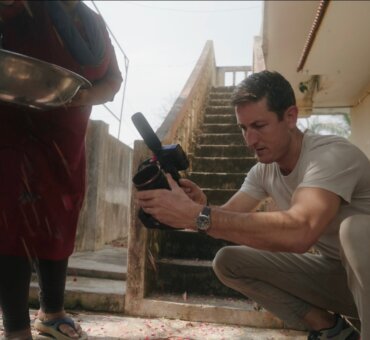In our book, great storytelling comes down to telling the truth. And by truth, we don’t necessarily mean the facts. It’s deeper than that. Great storytelling tells emotional truths, pulling authenticity out by any means necessary—Dina Rudick, founder of production company Anthem Multimedia, puts it this way:
“Here’s an absurdist thought experiment: Think about all the holes there would be if people took the time to take the dirt out of them. It sounds ridiculous, but the idea is there are stories everywhere, literally everywhere,” she told us. “You just have to uncover them. You just have to dig the dirt out of them.”
As filmmakers, it’s our job to do the digging. Interviewing for documentaries can be uncomfortable, because the truth is never simple. This is why documentaries are so important—they offer the time and context needed for the truth, as long as we can extract it.
The art of the interviewing for documentaries is a subtle dance, a balance between pushing and pulling, giving and taking. Dina is well-versed in this waltz. Before she founded Anthem Multimedia, she was an environmental photojournalist with The Boston Globe. Now, she and her team produce emotionally resonant, heart-rending short documentaries about real people overcoming real odds.
We asked her to offer a primer on interviewing for documentaries. It’s essential reading for anyone who’s ever wanted to tell a true story. Here’s Dina Rudick.

Over-Prepare
I like to have a goal in mind. It’s all about homework and research. I need to go into these interviews knowing what I ideally want people to say. Then, I get surprised—what they say is always better. But I have to go in knowing my shit cold. I need to be able to almost anticipate what they’re going to say, so that I know when I’m getting surface-level and when I’m getting deeper.
I like to actually write everything out. If you look at an example of my interview prep, it’s pretty extensive. I have a column for the category of question, and then I’ll have a column for the question, and then I’ll have a column for what is my imagined ideal answered. I never make them say that. That’s not how interviewing for documentaries works. But what it does is it guides my process.
When I storyboard for documentaries, I will make up an entire film on paper. My resulting film looks nothing like that, or at least it deviates in really meaningful, amazing, unexpected ways, which is what a documentary should do. But I have a grand thought experiment about it, grounded in research, about this person’s story.
There are a lot of pre-interviews. During interviews, it’s important not to take somebody to the place where you want them to go in your interview, because then they will give you a rehearsed interview. So, you have to ask your pre-production questions. It’s like a fact-finding mission, but not as an emotional deep-dive, because you won’t get that twice. You get it one time.
Crying is Not the Goal

The goal is not to get somebody to cry. People think that emotion means crying—that real, raw intimacy on-screen means you’re watching somebody cry. That is not the zenith. That is not the goal. And if that is the goal, then you’re being emotionally irresponsible with your subject. The goal is to be able to convey the fullness of that person’s emotion and experience.
People watching other people cry is uncomfortable for the viewer, and it’s really exposed and vulnerable for the subject. It has its place, but it is a small place. You want to bring people to that edge of understanding, to view the surface of emotion. Then, they get the experience of it without having to be thrown into lots of tears and messy sobbing. That’s not what you want.
It’s important your subject can trust that you’re not trying to break them down. They need to know you’re helping them convey their experience and you’re not trying to just mine them until they break. You will get their trust, and they will go new places with you. So, it’s important to know in an interview when you’re pushing too hard, and to allow things to breathe. To say things like, “I’m going to pause on that. Let’s come back to that.”
Instead of combating them and beating the good quotes out of them, take a step to their side and look at what they say with them. You’re looking at something together, rather than saying, “I’m going to ask you a question and get my answer. It’s mine.” That feels bad to everyone.
Instead of combating them and beating the good quotes out of them, take a step to their side and look at what they say with them.
Get the Unofficial Version
Sometimes I’ll say to my subjects that I feel like I just got the official version of their story. I’m clear on the logistics of it and I’m clear on the sequencing of it, but what I really want to know is, what did that feel like? What is the unofficial version?
You’ll know you’re getting a rehearsed version when the subject uses words like ‘you’ rather than words like ‘I’. That’s a good hint. When they start to pluralize things rather than making it individual to them. So, when I hear my subject going down that road, I often just let them finish that thought. Let them get through the first time.
And then I’m like, “All right. Got it.” I give it back to them in my understanding. I say, “Okay, so what you’re saying is X, Y, Z. But, what you just gave me is the generalized, spokesperson version of that. Tell it to me like you’re actually living it. Give it to me from you.” And then I ask the question again.
As an interviewer, I have to know what they’re trying to say and then I have to bring things out of the general and make it specific. I want to help them do that so it feels good to them in the process. It shouldn’t feel like they’re being exposed.
People love to be understood. That’s the motivation. That’s the reason journalism exists and storytellers can do their jobs, because people want to tell their stories. People want to be empathetically understood. If you can present yourself as an empathetic amplifier of their perspective, then everyone wins. You get to tell an amazing story and they get to be understood.

Don’t Be Afraid to Double-Down
When you look at my transcripts, you’ll see me revisit things again and again and again. I’ll go through the thought once. I’ll get their official version. Then, I say very self-consciously that we’re going to try it again. I’ll say something along these lines:
“I hear what you just said from this perspective. I’m really interested in going at this whole idea again with this angle, so humor me. Let’s do this all over. I don’t want you to repeat your words, let’s just go at this thought from a different entry point and see where it goes.”
Present it like an exploratory mission. It’s not just the facts now. It’s about figuring out how to tell this story from the right way to get where we want to go. I’ll make it clear that I don’t know where we’re going. It’s an interesting thought and I want to hear it from a different perspective.
I don’t want to say, “Can you say that again, but say it differently?” You don’t want to bring back to the attention that someone’s being interviewed, or that there’s two cameras pointing at them and they’re lit up like a billboard sign. They don’t want to be reminded of that. So, as much as you can, keep it in the realm of conversation and less about interviewing.
One last note about documentaries.
When we talked with Dina about her time as an environmental activist and reporter, she pointed out that even her own truths and beliefs were not enough to affect change. It wasn’t until she explored perspectives on both sides that actual change started to come.
This speaks to the beauty of filmmaking and documentary work. More than defending our own truths, real change comes when we attempt to understand other people’s truths. We’ll let Dina wrap up:
“I felt like staying in outrage and protest didn’t get you any place. It’s all about building a bridge of understanding and communication,” she told us. “In order to really speak with any kind of authority, I had to really understand it from perspectives that were opposite mine— to see the truth in where they were coming from. There’s a proverb that says, “To understand all is to forgive all.” The idea is that if you can wrap your head around a different perspective, conflict would cease. In that way, I think that moves towards a world that I want to live in.”
Need a reference for when you’re on-set? Download Dina’s tips for interviewing for documentaries by clicking the link below:



















































































